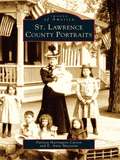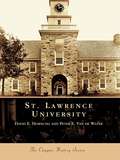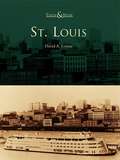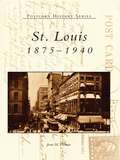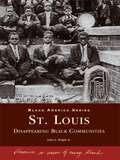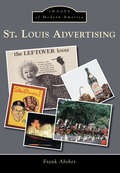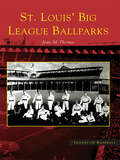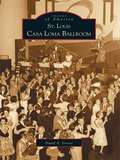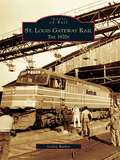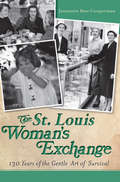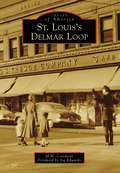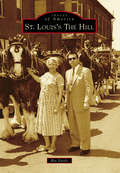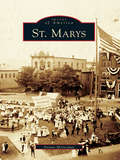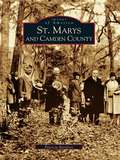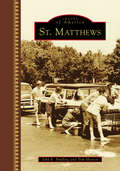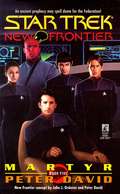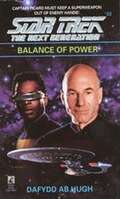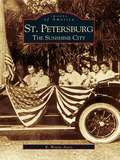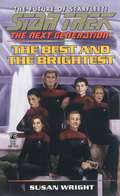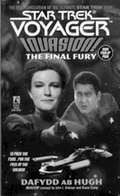- Table View
- List View
St. Lawrence County Portraits
by Patricia Harrington Carson E. Anne MazzottaSt. Lawrence County Portraits is a tribute to the citizens who shaped New York State's largest county. St. Lawrence is a county with many natural attributes: immense forests, navigable rivers, and vast tracts of fertile land. All of these have been instrumental in drawing people to the area. Reflected in St. Lawrence County Portraits are the influences of a strong mix of residents, including the Mohawks, who have called this area home for thousands of years, the European settlers, and those who trace their family history to Canada, just across the mighty St. Lawrence River.
St. Lawrence University (Campus History)
by David E. Hornung Peter E. Van De WaterFounded in 1856, St. Lawrence University is the oldest continuously coeducational institution of higher learning in New York State. Today, it offers a four-year undergraduate program of study in the liberal arts and enrolls approximately 2,000 students. St. Lawrence University looks back at a history that includes industry pioneers, government leaders, a law school, Madame Curie, the SS St. Lawrence Victory, movie stars, and sports legends. Originally chartered as a Universalist seminary and college of letters and science, St. Lawrence championed progressive ideas such as critical thinking and gender equality. The university of the late 19th century, although austere, offered nonacademic activities, including sports teams, a student government, the first Greek-letter organizations, and organizations for music, drama, social activism, and the literary arts. After weathering the Great Depression and World War II, the university grew dramatically; the four-building campus serving some 300 students in the early 1940s became a 30-building campus within 25 years.
St. Louis
by David A. LossosAs we approach the 241st anniversary of the settlement on the banks of the mighty Mississippi that came to be the metropolis of St. Louis, it is appropriate to look back at this great city. We have precious few physical reminders of the days of Laclede and Chouteau. It wasn't until the mid-19th century that we regularly recorded via photographs the development (and destruction) of the sights that make St. Louis unique. It is through these images that we have the marvelous capability to look back and view our city through the eyes of our predecessors: To see the things that were here decades ago and still look the same; to see things that no longer exist, and to see what we have replaced them with; to see what we have preserved, and what we have discarded; and to see the present via the images of the past. There is no way to encompass all the changes that this city has seen in one book. The views in this book will give the reader a representative selection of the more recognizable sights in the St. Louis metropolitan area. The intent is to include most of the major places and things that everyone identifies with St. Louis. But also included are more obscure photos that show scenes with which many of our ancestors would also identify. There will always be progress, but that which is lost is worth remembering. So sit back, relax, and take a stroll down the streets of St. Louis as our ancestors knew them.
St. Louis: 1875-1940 (Postcard History)
by Joan M. ThomasThe "beautiful city" described by early 20th century picture postcard senders still exists. The vintage postcard images presented here take you on a tour of St. Louis' burgeoning days, where you will revisit the grand architecture and neighborhoods of the early part of the last century. See Union Station in its original incarnation as a train station. Witness the grandeur of the 1904 World's Fair held at forever beautiful Forest Park. Plus, savor the charm of the city's many other parks, such as Lafayette Park, the site where baseball was first introduced to St. Louis. You will visit the thoroughfares of downtown St. Louis before it became necessary to rebuild and renovate. Finally, visit favorite places like Soulard Market, which have thrived from the beginning, maintaining a connection between the past and the present.
St. Louis: Disappearing Black Communities (Black America Series)
by John A. Wright Sr.Since the founding of St. Louis, African Americans have lived in communities throughout the area. Although St. Louis' 1916 "Segregation of the Negro Ordinance" was ruled unconstitutional, African Americans were restricted to certain areas through real estate practices such as steering and red lining. Through legal efforts in the court cases of Shelley v. Kraemer in 1948, Jones v. Mayer in 1978, and others, more housing options became available and the population dispersed. Many of the communities began to decline, disappear, or experience urban renewal.
St. Louis Advertising
by Frank AbsherMention "advertising," and just about everyone thinks of New York's Madison Avenue, long the center of the nation's advertising universe. The reality is that advertising is everywhere and has been almost since the inception of the nation. In St. Louis, for example, two early advertising agencies became major players on the national scene, creating advertising for multinational corporations. Browsing through this collection of old advertisements gives readers a chance to follow the development of the nation's business community over the past 200 years and see what was important in the daily lives of Americans, as well as what the nation's commercial interests wanted them to believe was important.
St. Louis' Big League Ballparks (Images of Baseball)
by Joan M. ThomasBaseball came to St. Louis before the dawn of the major leagues. It was a gentleman's game, a simple summer pastime, and its popularity grew as the city evolved. Local amateur teams proliferated, and interest in forming a team of professionals resulted in two such St. Louis teams in 1875, the Brown Stockings and the Red Stockings. The Browns and Reds played their home games at separate parks, the Grand Avenue Grounds and Red Stockings Park. The first fully professional game of baseball held in St. Louis took place at the latter. Very few modern fans are aware of this, or of these parks' locations. Moreover, there was a time early in the twentieth century when St. Louis supported not just two, but three major league teams, each with its own ballpark. This book is intended as a keepsake of the stadiums and playing fields of St. Louis' baseball past.
St. Louis Casa Loma Ballroom
by David A. LossosIn 1927, on the northeast corner of Cherokee and Iowa Streets in south St. Louis, a multistory, multipurpose building was erected. Retail shops and a bowling alley occupied the first floor, while upstairs was a place that defied the imagination of someone driving by in their brand new Model T Ford. Today, that upstairs space, with its lofty ceiling, huge maple tongue-in-groove dance floor, and wraparound balcony, is the Casa Loma Ballroom--St. Louis' last grand ballroom. Today, one gets the feeling that the ghosts of the big bands and the vocalists still linger there--and with good reason. Just about everybody who was anybody played there at one time or another. Ol' Blue Eyes himself, before he was the idol of millions, received just a meager "Featured Singer, Frank Sinatra" note at the bottom of the Casa Loma bill the night he played with the Harry James Orchestra.
St. Louis Gateway Rail: The 1970s
by Lesley BarkerThough the city of St. Louis is located on the Missouri side of the Mississippi River, for the railroads, the St. Louis Gateway extends into Illinois, north and south along both sides of the river. Two factors conspired against St. Louis's aspiration to become the preeminent rail center of the 19th-century American Midwest: there was no bridge across the Mississippi, and Missouri's loyalty to the Union during the Civil War was suspect. Chicago beat out St. Louis to attain the region's top railroad billing. Fast forward to the 1970s, when the Gateway Arch, dedicated in 1968, redefined the St. Louis riverfront and when the St. Louis Union Station closed to rail service. The 1970s was a decade of railroad debuts--Burlington Northern, Illinois Central Gulf, Family Lines--and a decade of railroad demises--Rock Island and Frisco. It signaled the end of a century of rail domination of the American transportation scene.
St. Louis Woman (Opera Biographies Ser.)
by Helen Traubel Richard G. HublerThis charming autobiography captures the life story of a fascinating woman: a Missouri girl-turned-world-class soprano who remained true to her roots through it all.Born and reared in St. Louis and proud of her origins, Helen Traubel grew up in a modest German-American family. She spent her teens and twenties singing with church choirs and quartets in the city, studying under first- rate teachers. She did not leave Missouri for New York until she was in her early thirties. Although she replaced the great Kirsten Flagstad at the Metropolitan Opera, she refused to confine herself to singing before elite crowds and prided herself on reaching a larger, more general audience via nightclubs, radio, television, and theater.St. Louis Woman is filled with candid and amusing stories as full of zest as Traubel herself. One such story details her audition for the Ford Hour, during which she suffered a terrible case of poison ivy, and the booth technicians interrupted her performance with laughter. Furious, she announced she would sing no more and started to leave. Without explanation, the technicians asked her to continue. Traubel later discovered that the higher-ups had called down to the technicians demanding they stop playing the Flagstad record and let that kid sing.The qualities that made Traubel such a notable individual are captured in this entertaining book. Her strong, independent character shines through. Outspoken and at times brutally honest, Traubel recounts her experiences at the Met, as both a popular performer and a teacher. She tells of exasperating moments when she was coaching famous pupil Margaret Truman. This is not a fact-laden examination of the singer’s Wagnerian repertory or a study of high opera; rather this engaging book introduces the reader to a nationally renowned performer who, despite her unmatched talent, retained her hometown identity and lived her life as a St. Louis woman.
The St. Louis Woman's Exchange: 130 Years of the Gentle Art of Survival
by Jeannette Batz CoopermanOn the surface, the Woman's Exchange of St. Louis is an exquisite gift shop with an adjacent tearoom--beloved, always packed, the chatter light and feminine, the salads and pies perfect. But the volunteers who run the Woman's Exchange have had enough grit to keep the place going through two world wars, a Great Depression, several recessions, the end of fine craftsmanship and the start of a new DIY movement. The "decayed gentlewomen" they set out to help in 1883 are now refugees from Afghanistan, battered wives and mothers of sons paralyzed in Iraq. Sample the radical changes they have made over the years, as well as the institutions they wisely left alone, like the iconic cherry dress that has charmed generations of women and mothers, including Jacqueline Kennedy and Gwyneth Paltrow.
St. Louis's Delmar Loop
by M. M. Costantin Joe EdwardsIn 1902, magazine publisher Edward Gardner Lewis needed greater space for his thriving business, then based in downtown St. Louis. He headed west, out Delmar Boulevard a mile past the city line, and bought five acres of open land adjacent to the loop in the trolley tracks that sent the 10D streetcar back downtown. By 1903, Lewis was building a complex that included the Woman's Magazine Building, a five-story octagonal tower with an eight-ton searchlight in its dome. In 1906, University City was incorporated, and Lewis became its first mayor, serving three terms. In 1913, Lewis went west again, this time to found the utopian colony of Atascadero, California. His octagonal dazzler is now University City's City Hall. In 2007, in its first such list, the American Planning Association named the Delmar Loop one of the country's "Great Streets"--it's a long story.
St. Louis's The Hill
by Rio VitaleThe Hill was named for its proximity to the highest point in St. Louis. Italians, mainly from Northern Italy, immigrated to the area starting in the late 1800s; however, by 1910, Sicilians were also immigrating to the Hill. Agencies in Italy were employed by mining companies and other industries to help Italian citizens gather all the required documentation for immigration. Italians came to the Hill because of its proximity to the factory and the mines and because it was a district that allowed them to purchase land and build a home. The Parish of St. Ambrose was founded 1903. After the original church was destroyed by fire, the new church was completed in 1926. The Hill has been home to some of St. Louis's nationally known residents, including baseball heroes Joe Garagiola and Lawrence "Yogi" Berra.
St. Marys (Images of America)
by Dennis McgeehanLocated in Elk County atop the Allegheny Mountains, Sancta Marienstadt (St. Marys) was founded in 1842 on the feast day of Mary. Establishing St. Marys as a refuge to preserve their German Catholic roots, the hardy pioneers of the area eventually embraced a multiethnic, progressive cityscape. Early settlers farmed and developed natural resources. When the extractive industries of timber, coal, and clay were exhausted, the town could have withered away. Instead, the industrious people turned to the newtechnologies of carbon and powdered metal. St. Marys flourished, becoming a leader in the world in these fields, and was labeled the "Carbon City." St. Marys recounts the success of this experiment through photographs from the St. Marys and Benzinger Township Historical Society, illustrating the many paths taken by the people of St. Marys to realize the faith of their founders.
St. Marys and Camden County
by Patricia BarefootBounded on the north by the Little Satilla River from neighboring Glynn County and on the east by the Atlantic Ocean, Camden County's southern boundary at the St. Marys River separates Georgia from Florida. Dating from a 1766 land grant, port of St. Marys and Camden County have faced a challenging past, present, and future. Camden's growth and development have been driven by businessmen, adventurers and opportunists, determined "wild swamp Crackers," and hardy, self-reliant, God-fearing men and women.Accompanied by Jonathan Bryan, a planter with an insatiable appetite for virgin tracts of land, Georgia's third and last Royal Governor James Wright visited Buttermilk Bluff in June 1767 and envisioned a city. St. Marys was born, and its street names reflect the surnames of the 20 founding fathers. While the county seat was removed from a quaint St. Marys on more than one occasion, today, the garden spot of Woodbine serves as the seat of county government. Formerly the rice plantation of J.K. Bedell, this small city shares a symbiotic relationship with port of St. Marys and the "City of Royal Treatment" at Kingsland. The history of the county, with its three main towns as well as the outlying, rural areas, unfolds in striking photographs from days gone by. Preserved within the pages of this treasured volume, images reveal Camden and its people in times of tragedy and triumph.
St. Mary's County
by Karen L. GrubberFor nearly four centuries, St. Mary's County has been called "the land of pleasant living." The county's fertile fields and pristine waters invite visitors and natives alike to revel, relax, and renew. As the "Mother County" of Maryland, St. Mary's has a rich written history dating from 1634, when George and Leonard Calvert established the first American settlement founded on the principle of religious tolerance. After surviving British raids during the War of 1812 and divided loyalties in the Civil War, the county leapt into the modern era when the US Navy established Naval Air Station Patuxent River, the Navy's premier flight test center and test pilot school. Today, millions of Americans trace their roots to Southern Maryland and are welcomed home as "Sons and Daughters of Old St. Mary's."
St. Matthews
by Tom Morton John E. FindlingSt. Matthews, once a prominent neighborhood of Louisville, is now a fourth-class city within metro Louisville. The first settlers came to the area in the 1780s, and for more than a century St. Matthews was largely an agricultural area where farmers specialized in growing potatoes. By 1900, a commercial district had grown at the intersection of several roads, known locally as the Point, and the land devoted to farming was gradually taken over by new commercial and residential development. After the great flood of 1937 and World War II, Shelbyville Road, the principal east-west street in St. Matthews, was the site of a commercial boom that included malls and other shopping centers, automobile dealerships, and a wide variety of other businesses. Today, the town of St. Matthews is a vibrant economic and cultural center that attracts people from all parts of metropolitan Louisville.
St New Frontier #5 Martyr: A Novel (Star Trek: The Next Generation #5)
by Peter DavidWith the fall of the ancient Thallonian Empire, civil war threatens the planet of Zondar. The arrival of the U.S.S Excalibur is greeted with relief and celebration by the anxious populace, and Captain Mackenzie Calhoun, fresh from his cataclysmic escape form the Thallonian throneworld, is acclaimed as their prophesied savior. But one believer's messiah is another's blasphemer -- and a prime candidate for martyrdom. When Captain Calhoun is captured, Lieutenant Commander Burgoyne must find him before an alien fleet launched a holy war against the Federation!
St The Next Generation Planet X (Star Trek)
by Michael Jan FriedmanMichael Jan Friedman is the author of nearly sixty books of fiction and nonfiction, more than half of which bear the name Star Trek or some variation thereof. Ten of his titles have appeared on the New York Times bestseller list. He has also written for network and cable television, radio, and comic books, the Star Trek: Voyager® episode ""Resistance"" prominent among his credits. On those rare occasions when he visits the real world, Friedman lives on Long Island with his wife and two sons. He continues to advise readers that no matter how many Friedmans they know, the vast probability is that none of them are related to him.
St Ng #33 Balance Of Power (Star Trek #No.33)
by Dafydd Ab HughWhen a famous Federation scientist dies, his son puts his inventions up for sale to the highest bidder, be they Federation, Klingon, Romulan, or Cardassian. Among the items at auction is a photon pulse canon capable of punching through a starship's shields with a single shot. Meanwhile, Wesley Crusher is kidnapped from the Academy by renegade Ferengi who have set their sights on the photon canon as well, and Captain Picard must outmaneuver enemies on every side to save Wesley and protect the EnterpriseTM from the deadly fire of the new canon.
St. Petersburg: The Sunshine City
by R. Wayne AyersIn the early 1900s, St. Petersburg, located on Florida's sunny Gulf Coast, was a place where dreams came true, where fortunes were won, and where thousands came to bask in the city's golden glow. "The Sunshine City" became its nickname and the advertising mantra that helped catapult St. Petersburg from a sleepy backwater of Tampa and a struggling rail stop to one of the nation's most popular tourist destinations. By the 1920s--often referred to as Florida's boom era--St. Petersburg saw fast and furious growth as the city's most significant institutions, buildings, and attractions came into being. Developers and promoters lured countless settlers and tourists from across the country by touting the city's many virtues and its perpetual sunshine. Almost overnight, St. Petersburg was transformed into a popular tourist mecca with a bustling downtown and waterfront, picturesque residential neighborhoods, lush parks and gardens, and the all the attractions of the day. This fascinating time was documented in both word and image by visitors, new residents, and the energetic players that made St. Petersburg boom.
St. Petersburg's Piers
by Nevin D. SitlerCommerce, tourism, recreation, and even the quest for eternal youth were the primary incentives for building piers along St. Petersburg's downtown waterfront as early as 1854. For more than 160 years, developers and entrepreneurs pushed wooden or concrete structures from the shoreline to the deeper waters of Tampa Bay. Railroads were behind the early development, allowing cargo loads to be transferred from ship to rail with the least amount of effort. A large and profitable fishing industry evolved. Electrically powered trolley cars shuttled tourists to and from cruise ships. Promoters built bathhouses, spas, and bait houses to entice locals and visitors, and casino gathering halls of various, often controversial, styles were proposed, built, destroyed, loved, and detested. Competing piers were built only 10 feet apart. Mother Nature's elements, including a hurricane, and politics ravaged most of the remaining structures.
St. Philip's Church of Charleston: An Early History of the Oldest Parish in South Carolina
by Margaret Middleton Eastman Dorothy Middleton AndersonSt. Philip's Church was commissioned shortly after the Carolina colony was founded in 1670. Because the Church of England was the established church, St. Philip's tried to meet the spiritual needs of the early settlers and also was responsible for oversight of elections, education and social services in everything from healthcare to disaster relief. St. Philip's churchwardens and vestry enforced morality laws and levied taxes. The colony's first state funeral--that of Governor Robert Johnson--took place in the church, as did that of the controversial, one-time vice president, Senator John C. Calhoun. Buried in the churchyard are Founding Fathers, pirate hunters, war heroes, statesmen and even the unfortunate victim of a sensational murder. This book recounts the early years of St. Philip's Church, the people who walked its aisles and some of the early religious conflicts that shook the community. Authors Dorothy Middleton Anderson and Margaret Middleton Rivers Eastman outline the fascinating history of the first church in the new colony.
St:the Best And The Brightest (Star Trek)
by Star Trek{\rtf1\ansi\ansicpg1252\deff0{\fonttbl{\f0\froman\fcharset0 Times New Roman;}{\f1\fnil\fcharset0 Arial;}} \viewkind4\uc1\pard\sb100\sa100\lang2057\f0\fs24 Every year, Starfleet Academy in San Francisco attracts many of the most talented and ambitious young people in the Federation. They come from all over the Alpha Quadrant, from hundreds of worlds and species, to prepare themselves for the challenges of the final frontier. \par Meet a new generation of cadets: a newly joined Trill just beginning the first of many lives; a Bajoran Vedek who finds himself torn between his vows and an unspoken love; a reckless young man fond of pushing the limits; a feline alien raised among humans; a brilliant but immature young woman with a lot to learn; and a native-born Earth woman with a talent for engineering. \par Together they will learn about courage, life, teamwork, and themselves. Their future is just beginning -- but one of them will not survive! \par \pard\f1\fs18 \par }
St Voy Vol #9: Final Fury (Star Trek #9)
by Dafydd Ab HughFor ages they have sought to claim our worlds. Now, at last, we take the battle to them. . . . Far from the Federation's desperate war against the invading Furies, the crew of the U.S.S. VoyagerTM encounters something they never expected to hear again: a Starfleet distress call. The signal leads them to a vast assemblage of non-humanoid races engaged in a monumental project of incredible magnitude. Here is the source of the terrible invasion threatening the entire Alpha Quadrant -- and, for the Starship VoyagerTM, a possible route home. But soon there may not be any home to return to . . .
